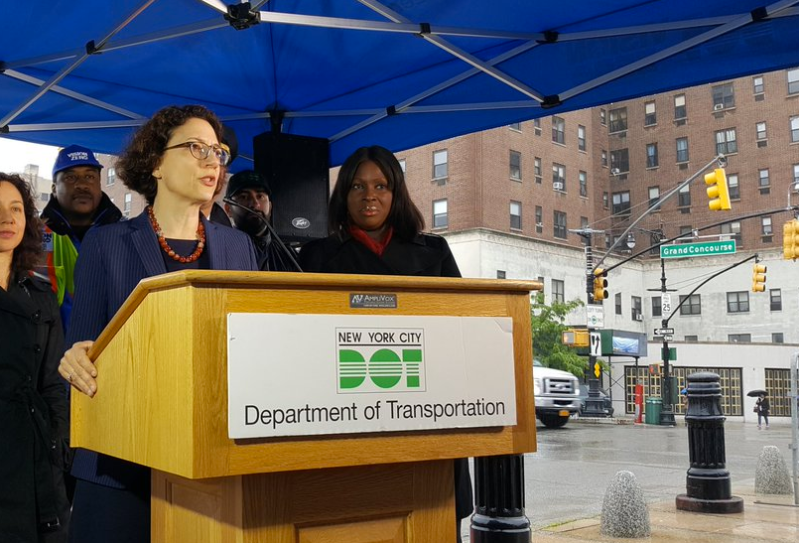The Goal for NYC Streets Should Go Beyond “Vision Zero” — The Grand Concourse Shows Why
The city has successfully reduced traffic injuries and deaths on one of the most dangerous streets in the Bronx, but without better conditions for biking and transit, the mission is not accomplished.

Transportation Commissioner Polly Trottenberg was in the Bronx yesterday to tout safety improvements on the Grand Concourse, historically one of the borough’s most dangerous streets for walking and biking.
There have not been any traffic deaths on the Grand Concourse in more than two years, according to DOT, and crashes with injuries have dropped 40 percent. These are significant achievements and testament to both street design changes and the de Blasio administration’s expansion of speed cameras, which cut speeding in school zones on the Concourse 70 percent.
But a lot more needs to change on the Grand Concourse, which still lacks safe, continuous bikeways and treatments to speed up trips for bus riders.
“It’s true that it’s safer in parts of the Grand Concourse now to cross the street, and there’s been measures taken to reduce speeding,” said Transportation Alternatives Bronx organizer Erwin Figueroa. “Unfortunately there’s two groups of people on the Grand Concourse that aren’t getting improvements: bikers and bus riders.”

In a statement, Mayor de Blasio compared progress on the Grand Concourse to Queens Boulevard, where protected bike lanes and expanded pedestrian space have reduced injuries and fatalities. “The Vision Zero news from the Grand Concourse is just as impressive,” the mayor said. “After major design changes by DOT, the street has seen dramatically fewer serious crashes and has also gone over two years without a fatality.”
The design changes on de Blasio’s watch consisted of a package of pedestrian safety fixes south of 158th Street. It was an important step to quickly reduce the risk of lethal driving on a dangerous street where a lot of people walk:

But comparing that project to Queens Boulevard underscores how the Vision Zero framework can easily gloss over important differences.
After the redesign of Queens Boulevard, injuries and fatalities fell, but that wasn’t the only big change. The number of people biking doubled. It’s safer not just in statistical terms, but in a way that makes people feel more secure getting around using a different mode of travel. Fear of biking has subsided.

Compare that to the Grand Concourse, where DOT has shown no intent to add bike infrastructure below 158th Street. (There are plans to add physical protection to the existing bike lanes north of 161st Street, but that construction could take years to finish.)
It makes sense for DOT and City Hall to tout the very real impact of their street safety policies — people should know that street design and speed cameras make a difference. But as anyone who bikes in the Bronx can tell you, it’s too early to declare “mission accomplished” on the Grand Concourse. It’s still dangerous enough to suppress bicycling on what should be a major bike corridor. The segments with bike lanes are obstructed too much, and while a few souls opt to ride in the main road’s painted median next to fast traffic, most people will never choose to do that.
The reduction of crashes and injuries is one goal — a very important one. What happens if you achieve that target while streets remain too dangerous for most people to consider biking and too slow for transit riders?
The goals for each street — especially major streets like the Grand Concourse — have to be more expansive. Vision Zero, on its own, is not enough.